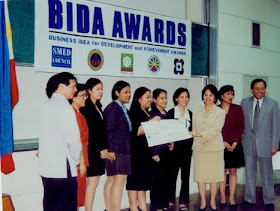Basi in small and long neck bottles (2 to 5 years aged) available. Contact avrotor@gmail.com or 9396331
Dr Abe V Rotor
Living with Nature School on Blog
Paaralang Bayan sa Himpapawid with Ms Melly C Tenorio
738 DZRB AM Band, 8 to 9 evening class, Monday to Friday
738 DZRB AM Band, 8 to 9 evening class, Monday to Friday
Rotor Basi won the distinct BIDA award in 2000. It sparked the revival of a sunset industry in the Ilocos Region. Top photo, the late former administrator Jesus T Tanchanco (right) of the National Food Authority and Mrs Alice Tanchanco pose with the author after receiving the BIDA Award. Lower photo, members of the winning team receive the cash award from BIDA, a joint project led by DOST and DTI (Small and Medium Industries), Philippine Chamber of Commerce and Industry (PCCI), and Planters Bank of the Philippines.

 Rotor Basi (made in San Vicente Ilocos Sur) has labels depicting the Ilocos Region's historical events, landmarks, and outstanding natives of the region - Ilocanos. Basi is a major attraction to tourists from different parts of the world. Basi is the only kind of table wine in the world.
Rotor Basi (made in San Vicente Ilocos Sur) has labels depicting the Ilocos Region's historical events, landmarks, and outstanding natives of the region - Ilocanos. Basi is a major attraction to tourists from different parts of the world. Basi is the only kind of table wine in the world..jpg)

The distinct mellow taste of basi comes largely from its aging time in burnay (earthen jars) - perhaps the only kind of tropical table wine processed and aged in this respected age-old tradition. The jars are kept to as long as ten years in home cellars or buried underground, and sealed hermetically with hard clay. Basi was once an important article of commerce in the region, and when the islands were colonized by Spain, basi reached Europe via the Galleon Trade passing through Acapulco, the tip of Mexico.
Basi sparked one of the major revolts against Spanish rule by the natives when wine monopoly was declared by the government. This meant virtually taking the industry from the hands of the natives. The short-lived uprising took place in Vigan, but the action took place on both sides of the Bantaoay River which runs through the towns of San Ildefonso and San Vicente, which are today major suppliers of Basi in Vigan's tourists' market.
Basi Revolt, 1807
The revolt took place 400 km north of Manila where Diego and Gabriela Silang heroically fought Spanish rule 50 years before. It was precipitated by the declaration of Wine Monopoly by the local Spanish government that virtually took from the hands of small cottage brewers an industry the Ilocos region enjoyed long before Spain colonized the islands. Basi was carried by the Galleon trade plying Ciudad Fernandina (now Vigan City) and Europe via Acapulco, Mexico (1565-1815).
The final battle took place along the Bantaoay River that runs through the town of San Vicente, some 4 km from the capital where the industry flourished. Scores of Spanish soldiers and natives were killed. Although the revolt spread to as far as Ilocos Norte, and Pangasinan to the south, it culminated on September 29, 1907 with the public execution of the captured rebels.
Fourteen big oil paintings depicting the Basi Revolt, also known as Ambaristo Revolt (named after its leader) can be seen today at the Vigan Ayala Museum, which is housed in the original residence of Filipino priest martyr, Fr. Jose Burgos. The painter, Don Esteban Villanueva was an eyewitness of this historic event. Today the original basi precariously hangs on few entrepreneurs who are probably descendants of the heroes of the Basi Revolt of 1807. (Text by Dr. A.V. Rotor)
Basi as well as its by-product Ilocos Vinegar (suka ti Ilocos, or sukang Iloko to the Tagalogs) meet rigorous European standards and US Food and Drugs Administration tests.











No comments:
Post a Comment